Humidifier
The Humidifier module provides modulating humidity control for humidifying and dehumidifying purposes. It can be used for water spray applications as well as for steam humidification. The humidity control is adjustable by parameter settings between minimum and maximum limits and is outside air compensated.
The module has inputs fo:
room/return air RH (RAH);
discharge air RH (DAH);
maximum RH (Hygrostat);
pump status or steam generator failure (HumidifierStatus);
and fan differential pressure (FanDiffPressure).
The outputs are for:
humidification (HUM);
dehumidification (DEH);
spray pump/steam generator enable (SPU);
pump/steam generator failure;
and related humidity high alarm (ALARM).
The module also generates signals as the internal variables HUM_Mode & DEH_Mode, which will be used by the Control module.
Humidity Control Delayed After the Fan Start
At the initial start of the air handling unit, all control functions assume normal temperature control before the humidity control is enabled. The humidity control will be delayed after the fan start (input FanDiffPressure must be true), e.g. 5 minutes, adjustable by parameter HUM_FanOnDelay. If the input FanDiffPressure becomes false during normal operation, the module will be blocked immediately. This feature reduces the risk of wet ducts on initial start-up and fan belt alarms.
Note: If the outside air temperature is below the value of parameter OAT_HighHum, only humidification can take place and if the outside air temperature is above the value of parameter OAT_LowDeh, only dehumidification is possible.
Four Types of Control
The module offers four different types of control, which can be selected by the control type parameter HumCtrlMode. The next table shows the control type possibilities.
HumCtrlMode | Type of humidity control |
|---|---|
Comfort Zone (1 on LCD) | Room/return air relative humidity P-control with adjustable comfort zone |
Return Hum (2 on LCD) | Room/return air relative humidity PI-control without comfort zone |
Disch Abs Hum (3 on LCD) | Discharge air absolute humidity PI-control with room/return air relative humidity reset (cascade control) |
Constant Disch Abs Hum (4 on LCD) | Constant discharge air absolute humidity PI-control |
Room/Return Air Humidity P-control with Comfort Zone (HumCtrlMode as Comfort Zone [1])
The humidity control module works in a typical sequencing application: humidifying and dehumidifying with an adjustable comfort zone between. In this case, the module uses two separate proportional controllers with internally calculated setpoints for humidification and dehumidification, depending on the value of the internal setpoint HumSpt and the adjusted comfort zone, defined by parameter HUMDEH_ComfZone.
The value of the HumSpt can be compensated by the winter- or summer-compensation functions. The separate humidify and dehumidify P-controllers have their own P-band, respectively defined by parameters HUM_P_band and DEH_P_band.
Note: With this type of control (HumCtrlMode as Comfort Zone [1]), the integral times of RAH_I_time and HUMDEH_I_time will be used 0 for a control loop by the program of the module.
The next figure shows the calculated setpoints for the two controllers, and the adjusted comfort zone, which is symmetric around the HumSpt. The figure shows also the P-band for the humidify controller, totally shifted below its calculated setpoint, and the P-band for the dehumidify controller totally shifted above the calculated setpoint. For plant modes, 1 to 3 calculated comfort zone increases fourfold.
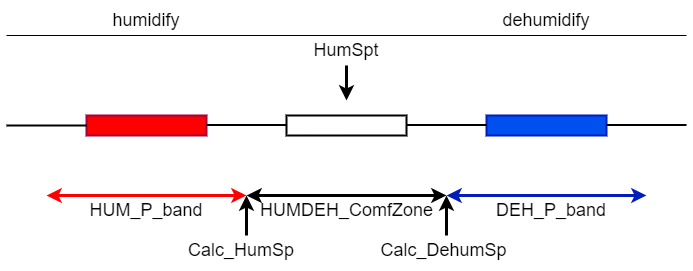
Humidification and dehumidification setpoints
The next figure shows the two P-controllers with shifted P-bands and calculated setpoints besides the adjusted comfort zone.
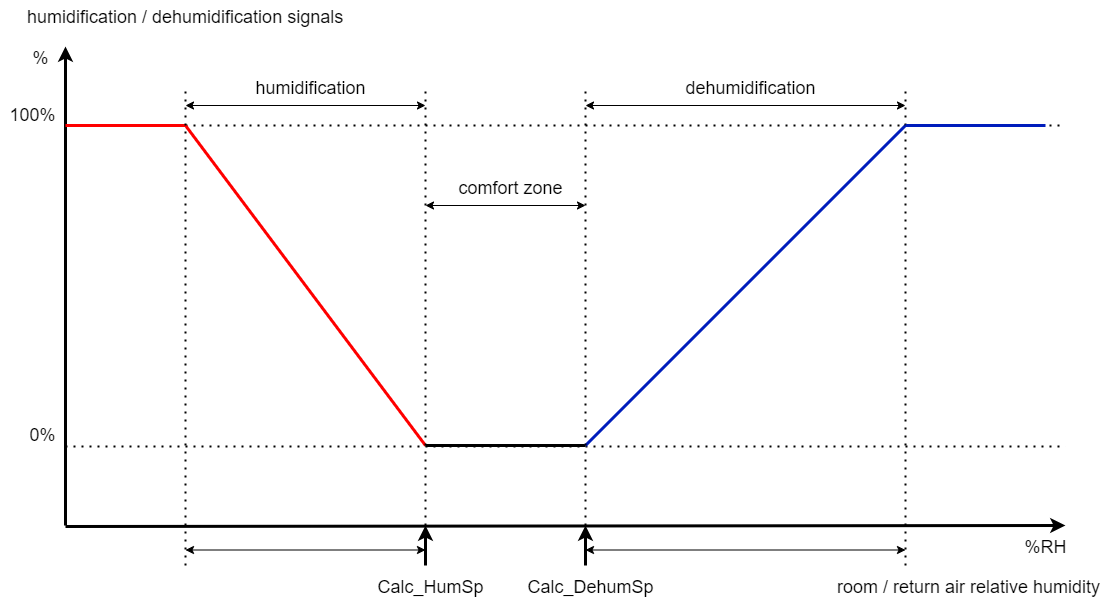
Humidification and dehumidification signals
Room/Return Air Humidity PI-control without Comfort Zone (HumCtrlMode as Return Hum [2])
The humidity control module works in a typical sequencing application: humidifying and dehumidifying. In this case, the module uses only two separate proportional and integral controllers with setpoints, defined by the value of the internal variable HumSpt. The value of the HumSpt can be compensated by the winter- or summer-compensation functions. The PI-controller has a proportional band, which is the summation of the P-bands respectively defined by parameters HUM_P_band and DEH_P_band. The integral time is defined by the parameter HUMDEH_I_time. The output control signal of this PI-controller sequences the module outputs HUM and DEH according to the rate of HUM_P_band and DEH_P_band, as shown in the figure of the Sequencing of the humidify and dehumidify output signals.
Discharge Air Absolute Humidity PI-control with RAH Setpoint Reset (HumCtrlMode as Disch Abs Hum [3])
The humidity control module works in a typical sequencing application: humidifying and dehumidifying. In this case, the module uses two proportional and integral controllers (master-slave or cascade control). The master PI controller is the room/return air relative humidity controller, which gets its setpoint from the internal variable HumSpt. The value of the HumSpt can be compensated by the winter- or summer-compensation functions. The master PI-controller P-band and I-time are respectively defined by the parameters RAH_P_band and RAH_I_time.
The slave PI-controller is the discharge air absolute humidity controller and its setpoint can be reset by the master PI-controller between the minimum and maximum values, as defined by the respective parameters DAH_LowAbsHumSpt and DAH_HighAbsHumSpt
Note: This type of control (HumCtrlMode as Disch Abs Hum [3]) is only possible when the absolute humidity of the discharge air has to be controlled because relative humidity will always be affected by undesired temperature fluctuations within the supply duct. So, the input DAH of the module must be connected to an absolute humidity sensor to calculate the absolute humidity from the temperature and the relative humidity in the supply air duct.
The next figure shows the relation between the room/return air humidity deviation and the discharge air absolute humidity setpoint.
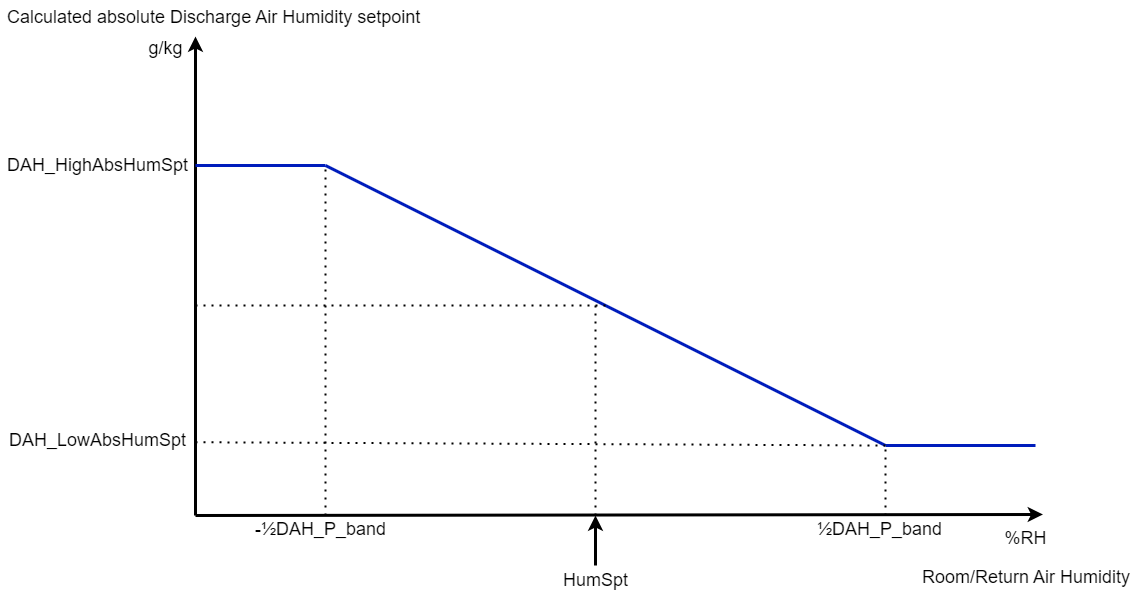
Absolute discharge air humidity setpoint according to the room/return air humidity
The slave PI-controller has a proportional band, which is the summation of the P-bands, respectively defined by the parameters HUM_P_band and DEH_P_band.
The output control signal of this slave PI-controller sequences the module outputs HUM and DEH according to the rate of HUM_P_band and DEH_P_band, as shown in the figure of the Sequencing of the humidify and dehumidify output signals.
Constant Discharge Air Absolute Humidity PI-control (HumCtrlMode as Constant Disch Abs Hum [4])
The humidity control module works in a typical sequencing application: humidifying and dehumidifying. In this case, the module uses two PI-controllers with setpoints, defined by the value of the internal variable HumSpt (this variable should be called in this case, e.g.: AbsDAHSpt). The PI-controller has a proportional band, which is the summation of the P-bands respectively defined by parameters HUM_P_band and DEH_P_band. The integral time is defined by the parameter HUMDEH_I_time. The output control signal of this PI-controller sequences the module outputs HUM and DEH according to the rate of HUM_P_band and DEH_P_band, as shown in the figure of the Sequencing of the humidify and dehumidify output signals.
Note: This type of control (HumCtrlMode as Constant Disch Abs Hum [4]) is only possible when the absolute humidity of the discharge air has to be controlled because relative humidity will always be affected by undesired temperature fluctuations within the supply duct. So, the input DAH of the module must be connected to an absolute humidity sensor to calculate the absolute humidity from the temperature and the relative humidity in the supply air duct.
Sequencing of Humidify and Dehumidify Output Signals
When HumCtrlMode equals 2, 3 or 4, the output signals for humidify and dehumidify will be sequenced according to the rate of values of HUM_P_band and DEH_P_band.
Example: Assuming that HUM_P_band=25 (100/25=4) and DEH_P_band=16.67 (100/16.67=6), then the internal signal of 0-100% is divided for humidification (40%) and dehumidification (60%).
The next figure shows the sequencing of the output signals of HUM and DEH.
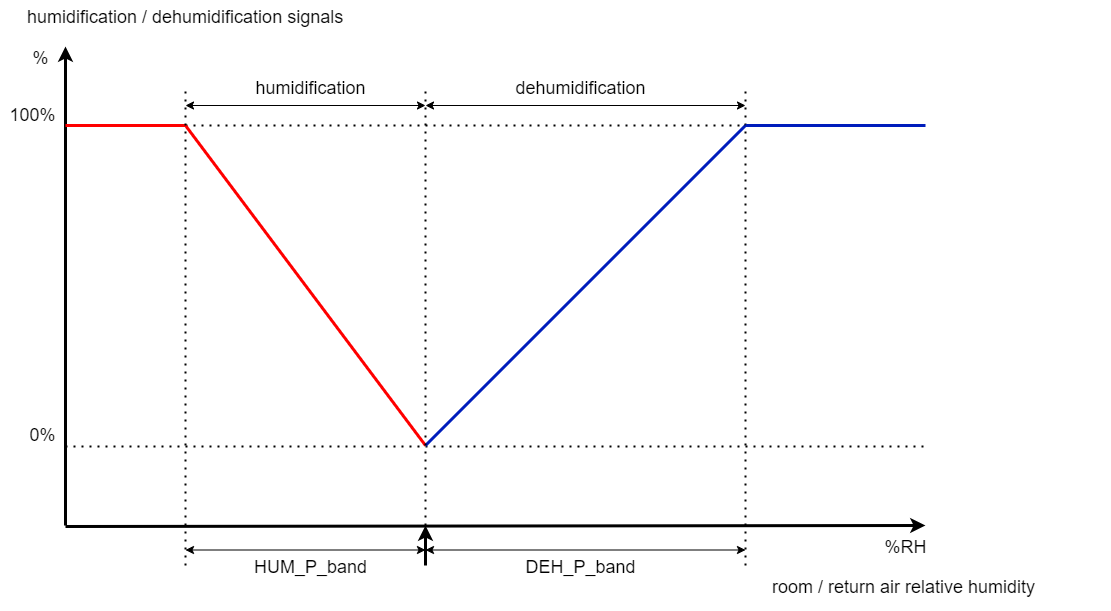
Sequencing of the output signal of humidification and dehumidification
Winter and Summer Compensation of the RH-setpoint
The calculated room RH setpoint is outside air compensated, defined by parameters WC_LowOAT, WC_HighOAT, SC_LowOAT, and SC_HighOAT, and limited between minimum and maximum values, defined by parameters RAH_MinHumSpt and RAH_MaxHumSpt, as shown in the next figure.
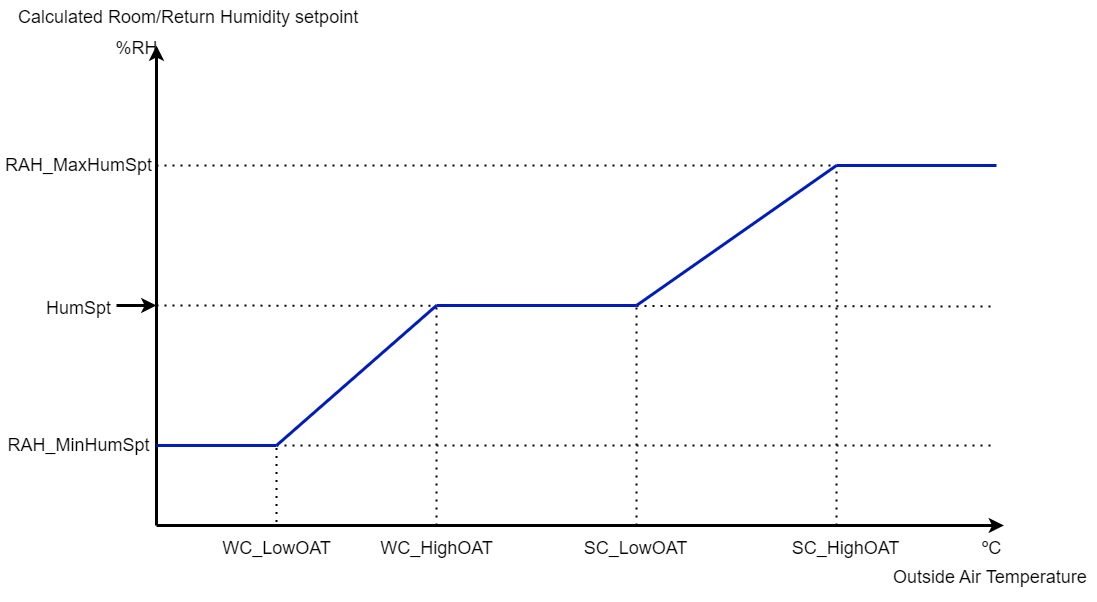
Room/return humidity setpoint according to the outside air temperature
Maximum RH Limitation of Discharge Air
To prevent the risk of wet ducts, the relative humidity is limited to a value, defined by the parameter DAH_MaxSpt. Depending on the maximum RH setpoint and the DAH_P_band the internal maximum RH control signal varies from 0 to 100%, as shown in the next figure.
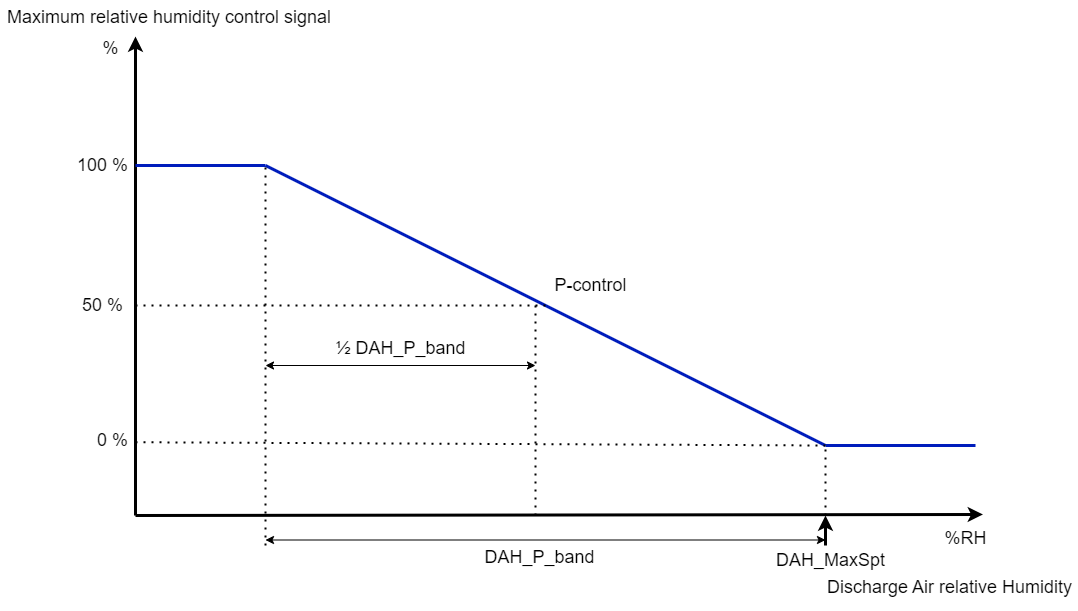
Maximum relative humidity control signal
A plausibility check is executed on the Hygrostat input, which means that only in the case of humidifying the Hygrostat input is monitored. When the maximum discharge air limit for hygrostat becomes true (=1), it will override the room RH control and generate an alarm at the internal variable HumHighAlarm.
Ramp-up of Control Signals
Both output signals, respectively for humidification HUM and dehumidification DEH will be ramped up in percents per minute, defined by parameters HUM_RampUp and DEH_RampUp, to ensure stable and efficient RH control, as shown in the next figure.
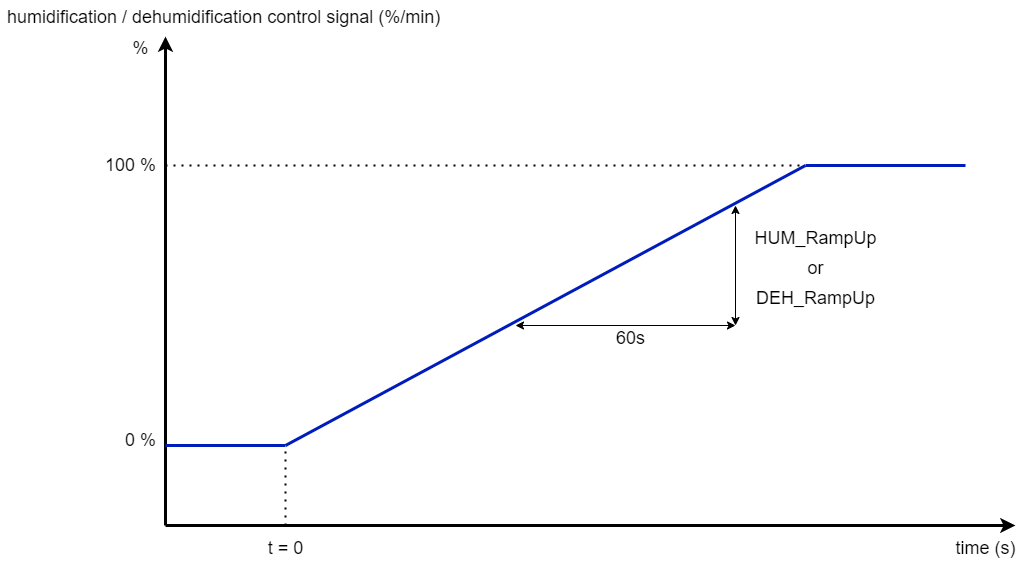
Ramp function for relative humidity control
Note: To speed up the ramp functions, the respective parameters HUM_RampUp and/or DEH_RampUp can be set to the value of 100. In that case, the signal will be raised at 100% per minute and this is faster than the runtime of the actuator that is normally used.
Selection of Spray Pump or Steam Humidifier
The selection of a spray pump or steam humidifier is done with the parameter HumidifierMode. If HumidifierMode is Water Humidifier [1], then the output SPU will switch on and off the spray pump, while in this case the output HUM most of the time will not be used. If HumidifierMode is Steam Humidifier [2], then the output SPU will act as a steam-generator enable signal, which is set to on during normal operation and will only be disabled in case of a failure.
Humidifier Status
In case the humidifier/pump status is connected, fail-to-command and humidifier/pump-off alarms are generated. The input can also be defined as a failure monitoring input for humidifier failure. When a failure or pump-off alarm occurs, the humidification output control signal (HUM) is directly set to 0%. Only in case of a failure, additionally, the output SPU is also switched off.
Selection of Alarms, Humidifier Status, or a Fail-to-command Alarm
With the parameter HUM_StatusAlarmDelay, it is possible to select different kinds of alarms for internal input Humidifier Status, as shown in the next table.
HUM_StatusAlarmDelay setting | Alarm output behavior |
|---|---|
> 1 | The status is monitored and differentiated off-alarms are generated, after the delay of parameter HUM_StatusAlarmDelay |
= 1 (default) | The status input will be handled as a failure input without delay (a logic 1 at the input means a failure condition) |
= 0 | No monitoring is done and no alarms are generated |
< 0 | The status is monitored and a fail-to-command alarm is generated at the on-alarm output, after the (absolute) time of the delay, defined by parameter HUM_StatusAlarmDelay |
Hygrostat
The internal variable Hygrostat generates an alarm when during humidification the relative humidity in the duct has exceeded the set level as defined by the maximum humidity. During dehumidification, the maximum hygrostat can cause an alarm because of the high relative humidity in the supply duct. In this case, the variable Hygrostat will not generate an alarm. The alarm will be reset automatically as soon as the Hygrostat input returns to normal. In the case of an HumHighAlarm, the humidification control signal is set to 0% and the spray pump/humidifier enable is set to off.
